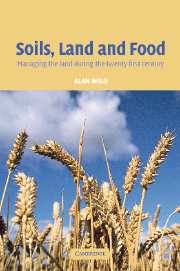Book contents
- Frontmatter
- Contents
- Preface
- Acknowledgements
- 1 Managing land for food production in the twenty-first century: an outline
- 2 Natural resources for sustainable land management
- 3 The development of agriculture and systems of land management
- 4 Maintaining and improving soil fertility
- 5 Land degradation and its control
- 6 Raising yields: use of fertilizers
- 7 Raising yields: water for rainfed crops and irrigation
- 8 Managing change of land use: seven examples
- 9 Increasing and sustaining agricultural production
- 10 Increasing agricultural production: the examples of Africa, India and China
- 11 Prospects and uncertainties
- References
- Index
6 - Raising yields: use of fertilizers
Published online by Cambridge University Press: 05 June 2012
- Frontmatter
- Contents
- Preface
- Acknowledgements
- 1 Managing land for food production in the twenty-first century: an outline
- 2 Natural resources for sustainable land management
- 3 The development of agriculture and systems of land management
- 4 Maintaining and improving soil fertility
- 5 Land degradation and its control
- 6 Raising yields: use of fertilizers
- 7 Raising yields: water for rainfed crops and irrigation
- 8 Managing change of land use: seven examples
- 9 Increasing and sustaining agricultural production
- 10 Increasing agricultural production: the examples of Africa, India and China
- 11 Prospects and uncertainties
- References
- Index
Summary
INTRODUCTION
During the early part of the nineteenth century, sodium nitrate (Chilean nitrate) and Peruvian guano were imported into Europe, and more significant developments followed. They included the manufacture of superphosphate in England from 1843, by treating first bones and then rock phosphate with sulphuric acid. Two industrial by-products came into importance in the nineteenth century: ammonium sulphate as a by-product in the manufacture of coal gas, and basic slag which contained phosphate from the impure iron oxide used in the steel industry. From 1861 potassium salts became available for use as fertilizer from deposits in Germany, and later from elsewhere. In the twentieth century three important manufacturing processes were (ⅰ) the synthesis of ammonium fertilizers by the Haber–Bosch process, which originated in Germany during the first two decades, (ⅱ) the manufacture of triple superphosphate, which was started by the Tennessee Valley Authority (USA) in the 1930s, and (ⅲ) the manufacture of urea from atmospheric nitrogen and natural gas from oil drilling, which became a cheap and increasingly popular nitrogen fertilizer from the 1950s.
FERTILIZER USE DURING THE TWENTIETH CENTURY
Fertilizer use is essentially a phenomenon of the twentieth century. Many books and thousands of scientific papers have been published on the need for fertilizers and on their uses. The books include those by Cooke (1967, 1982), Sanchez (1976), Wild (1988), Rengel (1998, 1999) and Laegreid et al. (1999).
- Type
- Chapter
- Information
- Soils, Land and FoodManaging the Land during the Twenty-First Century, pp. 93 - 108Publisher: Cambridge University PressPrint publication year: 2003



